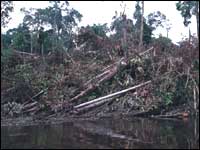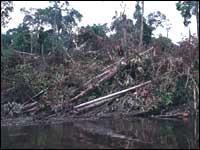Bjorn Lomborg opens his chapter on biodiversity by citing my 1979 estimate of 40,000 species lost per year. He gets a lot of mileage out of that estimate throughout the chapter, although he does not cite any of my subsequent writings except for a single mention of a 1983 paper and a 1999 paper, neither of which deals much with extinction rates. Why doesn’t he refer to the 80-plus papers I have published on biodiversity and mass extinction during the 20-year interim?
In this respect as well as others, Lomborg seems to be exceptionally selective. As my 1979 book emphasizes, the estimate of 40,000 extinctions per year was strictly a first-cut assessment, preliminary and exploratory, and advanced primarily to get the issue of extinction onto scientific and political agendas. If Lomborg had checked my many subsequent analyses (totaling one quarter of a million words) in the professional literature instead of taking me to task for providing “no other references or argumentation,” he would have found more documented, modified, refined, and generally substantiated estimates.
Lomborg is equally sloppy in his analyses of the utilitarian benefits of species and their genetic resources — for example, “aspirin from willow trees, heart medicine from foxgloves.” It is simply not true, as Lomborg claims, that, “Most of this medicine is now produced synthetically.” In several instances, scientists have tried for decades to synthesize plant-derived alkaloids and other biocompounds in the laboratory, investing huge amounts of money in the effort, to little or no avail. Yet Lomborg goes on to assert, “But so long as we do not even have any practical means of analyzing even a fraction of those plants already known to us, this cannot be used as a general argument for the protection of all species, for example in the rain forest.” He might check with the National Cancer Institute in Bethesda, Md., where scientists have demonstrated that certain families of plants appear to be sound bets for medical breakthroughs.

But again, Lomborg seems disinclined to undertake even a fraction of the homework that could give him a preliminary understanding of the science in question. He does not cite any of the findings of the dozens of pharmacognosy experts and economists who have demonstrated that, for example, the two anti-cancer drugs derived from the rosy periwinkle generate commercial sales on the order of $400 million per year, with economic benefits vastly greater (based on the $12 million value for each of the 30,000 American lives saved each year). The extensive literature on this issue seems to have entirely escaped Lomborg’s attention. More important, as concerns the myriad benefits of safeguarding the planetary spectrum of species, Lomborg appears indifferent to what may be the most important benefit of all: the “ecosystem resilience” stemming from the abundance and variety of species. Again, there are stacks of documentation and evaluation of ecosystem resilience that Lomborg ignores. Nor does he offer even a passing mention of the existence value, the bequest value, and other non-market values invoked by economists specializing in the field of biodiversity and species preservation.
Extinction Is Forever
Similarly, Lomborg ignores or is ignorant of much of the work on extinction rates. (Although this doesn’t stop him from sniping at scientists who are experts in the field: On extinction estimates generally, Lomborg writes that, “Biologists have a clear opinion of where the debate between figures and models should end. There are many grants at stake.” This is one of many instances in which Lomborg casts extraordinary slurs on the professional integrity of biologists.)
Lomborg asserts that despite the heavy deforestation of the eastern forests of the United States, only one forest bird has become extinct. But what he fails to recognize is that this is plainly a forest bird whose existence is known and whose conservation/extinction status is likewise known. What about the unknowns? How about the extensive analyses of Stuart Pimm, John Gittleman, Tom Brooks, and others who conducted in-depth assessments and came up with findings quite the opposite of Lomborg’s assertion? Lomborg goes on to speak of “the largest tropical study of the correlation between rain forest and the extinction of species,” viz. Puerto Rico; but detailed studies have been conducted in far larger islands such as New Guinea, the eco-zone of Polynesia/Micronesia and elsewhere. With respect to Puerto Rico, the findings of Ariel Lugo cited by Lomborg have been repeatedly rebutted by long-standing experts such as Storrs Olson, who are not mentioned.

Illegal logging in Ecuador.
Photo: ArtToday.
Lomborg quotes Heywood and Stuart to the effect that, “Recorded extinction figures for mammals and birds are ‘very small,'” before extrapolating the extinction rate to all other species. Note the vital word “recorded.” As Lomborg has earlier indicated, the vast majority of species are still unknown to science, hence their existence/extinction status is likewise unknown — except that there is extensive evidence that many species that once existed are now gone. On the Centinella mountain ridge in Ecuador, Al Gentry discovered “something like 90 species of plants found nowhere else.” Shortly after Gentry’s visit, the ridge was totally deforested, but in subsequent years he “refound at least 17 of the previously assumed lost species.” Lomborg cites that as if it is a triumph, but what about the remaining 73 species? Is that not a significant loss?
The unknown-species factor, crucial to any analysis of extinction rates, suggests that unrecorded extinctions are surely frequent, to say the least. If Lomborg wanted to check on the latest extinctions findings by scientists of global stature, he could consult the work of Peter Raven, Michael Soule, and David Woodruff, among dozens of other well-established and highly credentialed biologists. To be sure, there is not always “clear-cut evidence” available. But when we are dealing with a phenomenon, like mass species extinctions, that involves unique entities undergoing irreversible injury, we should take into account even evidence that is less than definitive.
Skeptic Tank

In summary, Lomborg adopts an exceptionally cavalier approach to mass extinction, utterly failing to acknowledge it as a phenomenon that will impoverish the planet for millions of years to come. Extinction ranks as the environmental problem that will exert far and away the most enduring impact on future generations. As such, surely it warrants a more informed, considered, and generally professional response than the one offered by Lomborg — a man who demonstrates repeatedly that he is not acquainted with the basics of the issue. I presented a detailed critique of the naysayers’ viewpoint in my 1994 debate book with Julian Simon. While Lomborg cites certain other writings of Simon, he seems indifferent to this one, and to my detailed rebuttals. If he had looked, he would have seen an evaluation of the key factor of scientific uncertainty, which remains as apt a response to Lomborg as it was to Simon:
A skeptic might still object that if the extinctions are occurring in large numbers right now, why aren’t they individually documented? How much precise evidence is there? To this, the pragmatic scientist responds that it is far easier to demonstrate that a species exists than that it does not. To achieve the first, all one has to do is to find a few specimens. To achieve the secon
d with equal certainty, one would have to search every last locality of the species’ range before finally being sure. This is alright for the purist. Unfortunately, we live in a world without sufficient scientists, funding, and, above all, time to undertake a conclusive check. Given that we are witnessing a mass extinction of exceptional scope, should it not be sufficient to make a best-judgment estimate of what is going on — and in cases of uncertainty (“Has the species finally disappeared or is it still hanging on?”), assume that if a species has not been seen for decades, it should be considered to be extinct until it is proven to be extant? Conservation organizations generally require that a species fail to be recorded for 50 years before it can be designated in memoriam. In Peninsular Malaysia, a four-year search for 266 species of freshwater fish turned up only 122 of them, yet they are all officially regarded as still in existence.Let us bear in mind, above all, that we are dealing with the irreversible loss of unique life forms. It is not always possible to detail the precise survival status of tens of thousands of threatened plant species and millions of animal species. In light of these factors, why shouldn’t the burden of proof be shifted onto the shoulders of the skeptics, so that they must prove a species’ existence rather than the reverse?
This brings up a key question as concerns species extinctions. What is “legitimate scientific caution” in the face of uncertainty? Uncertainty can cut both ways. Some observers may object that in the absence of conclusive evidence and analysis, it is appropriate to stick with low estimates of species extinctions on the grounds that they are more “responsible.” But how about the crucial factor of asymmetry of evaluation? A low estimate, ostensibly “safe” because it takes a conservative view of such limited evidence, may fail to reflect the real situation just as much as an “unduly” high estimate that is more of a best-judgment affair, based on all available evidence with varying degrees of demonstrable validity. In a situation of uncertainty where not all parameters can be quantified to conventional satisfaction, let us not get hung up on what can be counted today if that is to the detriment of what ultimately counts. Undue caution can readily become recklessness; and as in other situations beset with uncertainty, it will be better for us to find we have been roughly right than precisely wrong.


